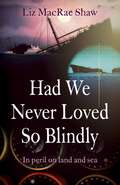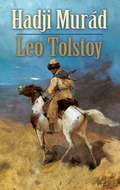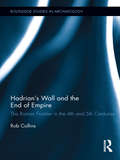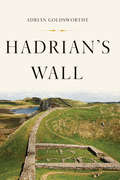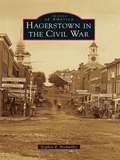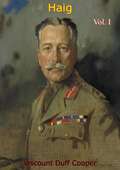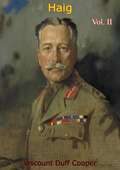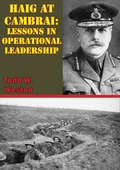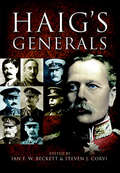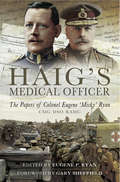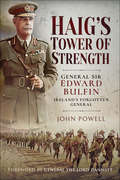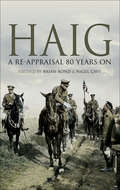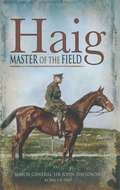- Table View
- List View
Hacking ISIS: How to Destroy the Cyber Jihad
by Malcolm Nance Christopher SampsonThis book is written by two of the leading terrorist experts in the world - Malcolm Nance, NBC News/MSNBC terrorism analyst and Christopher Sampson, cyber-terrorist expert. Malcolm Nance is a 35 year practitioner in Middle East Special Operations and terrorism intelligence activities. Chris Sampson is the terrorism media and cyber warfare expert for the Terror Asymmetric Project and has spent 15 years collecting and exploiting terrorism media. For two years, their Terror Asymmetrics Project has been attacking and exploiting intelligence found on ISIS Dark Web operations.Hacking ISIS will explain and illustrate in graphic detail how ISIS produces religious cultism, recruits vulnerable young people of all religions and nationalities and disseminates their brutal social media to the world.More, the book will map out the cyberspace level tactics on how ISIS spreads its terrifying content, how it distributes tens of thousands of pieces of propaganda daily and is winning the battle in Cyberspace and how to stop it in its tracks.Hacking ISIS is uniquely positioned to give an insider’s view into how this group spreads its ideology and brainwashes tens of thousands of followers to join the cult that is the Islamic State and how average computer users can engage in the removal of ISIS from the internet.
Had We Never Loved So Blindly: In Peril On Land And Sea
by Liz MacRae Shaw'Raw and radiant in turn, Had We Never Loved So Blindly, is a sweeping portrayal of love, loss and longing in wartime Scotland. Felicity and John Norman will stay with me for a long time.' Barbara Henderson, author of Fir for LuckIn 1937, fisherman's son, John Norman's first encounter of Felicity MacDougall, the daughter of a retired tea planter, is prickly at best. But, a chance meeting during a London air raid leads to a tentative romance, which becomes long distance when John joins the Navy and Felicity takes a job at the famous, secretive Bletchley Park. Their relationship falls prey to the timeless obstacles of insecurities, doubts and misunderstandings. Can they overcome the distance between them, and also the war? This love story, forged amid the emotional intensity of WW2, is the beating heart of Liz MacRae Shaw's new novel. John and Felicity's relationship has fateful consequences, not only for them, but beyond, into the next generation...
Hadji Murad
by Leo TolstoyTolstoy's novella blends fiction and historical fact to portray a legendary Avar chieftain who switched sides in the nineteenth-century Russo-Caucasian war. Inspired by the author's military service, Hadji Murád offers riveting views of warfare and treason, murder and vengeance, and behind-the-scenes political plotting. An uncharacteristically brief story by the creator of War and Peace, it voices Tolstoy's pacifist beliefs. This novella also provides a compelling depiction of the Caucasus, a mountainous territory between the Black Sea and the Caspian, prized for its strategic location and natural resources. Located at the crossroads of three empires — Turkey, Persia, and Russia — the region has long struggled with incursions by its neighbors and remains a troubled corner of the world to this day. Tolstoy's realistic pictures of life in a war zone raise enduringly relevant issues of life and death.
Hadrian's Wall and the End of Empire: The Roman Frontier in the 4th and 5th Centuries (Routledge Studies in Archaeology)
by Rob CollinsThere is no synthetic or comprehensive treatment of any late Roman frontier in the English language to date, despite the political and economic significance of the frontiers in the late antique period. Examining Hadrian’s Wall and the Roman frontier of northern England from the fourth century into the Early Medieval period, this book investigates a late frontier in transition from an imperial border zone to incorporation into Anglo-Saxon kingdoms, using both archaeological and documentary evidence. With an emphasis on the late Roman occupation and Roman military, it places the frontier in the broader imperial context. In contrast to other works, Hadrian’s Wall and the End of Empire challenges existing ideas of decline, collapse, and transformation in the Roman period, as well as its impact on local frontier communities. Author Rob Collins analyzes in detail the limitanei, the frontier soldiers of the late empire essential for the successful maintenance of the frontiers, and the relationship between imperial authorities and local frontier dynamics. Finally, the impact of the end of the Roman period in Britain is assessed, as well as the influence that the frontier had on the development of the Anglian kingdom of Northumbria.
Hadrian's Wall: The Landmark Library (The\landmark Library #6)
by Adrian GoldsworthyFrom an award-winning historian of ancient Rome, a definitive history of Hadrian's WallStretching eighty miles from coast to coast across northern England, Hadrian's Wall is the largest Roman artifact known today. It is commonly viewed as a defiant barrier, the end of the empire, a place where civilization stopped and barbarism began. In fact, the massive structure remains shrouded in mystery. Was the wall intended to keep out the Picts, who inhabited the North? Or was it merely a symbol of Roman power and wealth? What was life like for soldiers stationed along its expanse? How was the extraordinary structure built--with what technology, skills, and materials?In Hadrian's Wall, Adrian Goldsworthy embarks on a historical and archaeological investigation, sifting fact from legend while simultaneously situating the wall in the wider scene of Roman Britain. The result is a concise and enthralling history of a great architectural marvel of the ancient world.
Hagerstown in the Civil War (Images of America)
by Stephen R. BockmillerWedged strategically between the Mason-Dixon Line and the Potomac River, Hagerstown was destined to play a significant role in the Civil War. A diverse community, most residents gravitated toward the blue while some sided with the gray. Slavery was not a major presence in western Maryland, yet some local residents owned slaves along this route on the Underground Railroad. The intriguing story of Hagerstown during the Civil War is captured in this volume of vintage photographs, portraits, drawings, and other illustrations. Learn the stories of participants, both local and from across the country, whose wartime experiences in Hagerstown forever affected them. From the secretive arrival of John Brown in June 1859, to recent efforts to commemorate this history, the reader will come to understand the rich heritage that can be found in Hagerstown.
Haig - Vol. I (Haig #1)
by Viscount Duff CooperOriginally published in 1935, this is the first volume of the autobiography of Field Marshal Douglas Haig, 1st Earl Haig (1861-1928), who commanded the British Expeditionary Force on the Western Front from late 1915 until the end of WWI. He was commander during the Battle of the Somme, the Third Battle of Ypres, and the Hundred Days Offensive, which led to the armistice of 11 November 1918.Written with access to Earl Haig's fulsome dairies that he kept throughout the First World War, noted biographer Duff Cooper, gives a rare and in-depth look at the head of the British war effort on the Western Front.
Haig - Vol. II (Haig #2)
by Viscount Duff CooperOriginally published in 1935, this is the first volume of the autobiography of Field Marshal Douglas Haig, 1st Earl Haig (1861-1928), who commanded the British Expeditionary Force on the Western Front from late 1915 until the end of WWI. He was commander during the Battle of the Somme, the Third Battle of Ypres, and the Hundred Days Offensive, which led to the armistice of 11 November 1918.Written with access to Earl Haig's fulsome dairies that he kept throughout the First World War, noted biographer Duff Cooper, gives a rare and in-depth look at the head of the British war effort on the Western Front.
Haig At Cambrai: Lessons In Operational Leadership
by Todd W. WestonThe dynamic nature of the British operation at Cambrai in 1917, in particular related to the actions of the British CINC Douglas Haig, provides useful insights into the nature of operational leadership for today. This is true in large part because the Cambrai operation came at a time when technology, tactics and strong political pressure came together to exert their combined influence on all levels of war, particularly the operational level. A similar situation exists today. The primary lessons which can be drawn from Haig's experience as an operational commander at Cambrai include; the need to define and communicate the commander's intent, an operational commander's need to avoid involving himself at the tactical level, and the requirement for an operational commander to examine carefully his motives for deciding on a particular course of action.
Haig's Generals
by Steven J. CorviAn in-depth study of Douglas Haig's army commanders on the Western Front during the First World War. Assesses their careers and characters, looks critically at their performance in command and examines their relationship with their subordinates and with Haig himself. Chapters are devoted to Allenby, Byng, Birdwood, Gough, Horne, Monro, Plumer, Rawlinson and Smith-Dorrien. Offers a fascinating insight into the mentality of these men and into their methods as they sought a solution to the problem of war on the Western Front. A fascinating and original contribution to the history of the war in the trenches.Contributors include: John Bourne, Matthew Hughes, John Lee, William Philpott, Simon Robbins, Gary Sheffield, Peter Simkins, Ian F. W. Beckett, Steven J. Corvi.
Haig's Intelligence
by Jim BeachHaig's Intelligence is an important new study of Douglas Haig's controversial command during the First World War. Based on extensive new research, it addresses a perennial question about the British army on the Western Front between 1916 and 1918: why did they think they were winning? Jim Beach reveals how the British perceived the German army through a study of the development of the British intelligence system, its personnel and the ways in which intelligence was gathered. He also examines how intelligence shaped strategy and operations by exploring the influence of intelligence in creating perceptions of the enemy. He shows for the first time exactly what the British knew about their opponent, when and how and, in so doing, sheds significant new light on continuing controversies about the British army's conduct of operations in France and Belgium and the relationship between Haig and his chief intelligence officer, John Charteris.
Haig's Medical Officer: The papers of Colonel Eugene 'Micky' Ryan CMG DSO RAMC
by Eugene RyanDespite countless conflicting assessments, Field Marshal Douglas Haig remains one of the most controversial and fascinating characters in British military history. To some he was a mindless butcher, to others a true patriot who masterminded Allied victory in the First World War under the most trying circumstances.The papers of Colonel Eugene 'Micky' Ryan, Haig's long serving doctor and confidant, are a significant find as they throw fresh and invaluable light on the life and character of this enigmatic man. Ryan studied medicine at Cork and Edinburgh. He was commissioned into the RAMC in 1901 and saw active service in South Africa. He first met Haig in 1912 and became Medical Officer to Haig's HQ 1st Corps in 1914 and moved with him to 1st Army that December. Ryan saw service commanding two Casualty Clearing Stations before being appointed Medical Officer to the C in C (Haig) in September 1916.Haig's and Ryan's relationship, while primarily professional, blossomed into a friendship of mutual respect and trust which lasted until Haig's death in 1928. Ryan delivered the Haigs' long awaited heir, Dawyck, in 1918 and advised during Dorothy Haig's illness in 1926.Fortunately Ryan kept meticulous diaries which, written from such a unique viewpoint and with constant reference to Haig and his family, are of historical importance: the Foreword, written by Professor Gary Sheffield a leading authority on Haig's life and work, attests to their significance.As seen in Britain at War Magazine, January 2014
Haig's Tower of Strength: General Sir Edward Bulfin—Ireland's Forgotten General
by John PowellThis is the first biography of General Sir Edward Bulfin, who rose to high rank despite his Catholic Irish republican background, at a time when sensitivities were pronounced. Not only that but by the outbreak of the Great War, Bulfin was a brigade commander despite having not attended Sandhurst or Staff College and never commanding his battalion.In his early career he was a protg of Bullers and he made his name in the Boer War. In 1914 Haig credited him with saving the day at First Ypres despite being wounded and gave him 28th Division. Unable to get on with Gough, he was sent home. He raised the 60th London Division and took it to France, Salonika and Egypt where Allenby chose him to command a corps. His success against the Turks at Gaza, Jerusalem and Megiddo justified Allenbys confidence.Despite ruthlessly crushing disturbances in post-war Egypt, Bulfins beliefs and background led him to refuse Churchills order to command the police and army in Ireland.A private man, Bulfin left few letters and no papers and the author is to be congratulated on piecing together this fascinating biography of an enigmatic military figure.
Haig: A Re-Appraisal 80 Years On
by Brian Bond, Nigel CaveField Marshal Earl Haig's reputation continues to arouse as much interest and controversy as ever. This volume represents the collaboration of two leading historical societies, The British Commission for Military History and The Douglas Haig Fellowship. Leading historians have produced a comprehensive and fascinating study of the most significant and frequently debated aspects of Haig's momentous career.
Haig: Master of the Field
by John P. DavidsonA distinguished soldier who had served in South Africa, the Author was selected to be Haigs Director of Operations in 1915, a key position he held until the end of the War. This book concentrates on the dramatic events of 1917 and 1918 and covers Third Ypres, the German onslaught (Kaiserschlacht), and the victorious 100 Days. We learn of the parlous state of the French Army, their loss of morale and the widespread mutinies.Tavish Davidsons viewpoint on the conduct of operations was unique and we learn of the factors at play in Haigs HQ. The German U-Boat fleets ports became a high priority as losses of shipping mounted, threatening the whole war effort. We get the German perspective Passchendaele 1917 was even more costly for them than the Allies.Davidson comes down wholeheartedly on Haigs side but this should not be a surprise as Haig was revered by his officers and men. It only became fashionable to pillory him much later.This is an important addition to the bibliography of the Great War.
Haking: Lt Gen Sir Richard Haking, XI Corps Commander 1915–18, A Study in Corps Command
by Michael SeniorSir Richard Haking commanded the British XI Corps from 1915 to 1918 mainly in France, but also in Italy (December 1917-March 1918). This first study of Haking takes the form of a review and analysis of his career as a Corps Commander, placing the activities of XI Corps in the context of events on the Western and Italian Fronts. It has three aims. First, it is intended to make a balanced assessment of Haking as a Corps Commander in the light of an established popular reputation, which places him firmly in the donkey category of First World War generals. The second aim is to examine how Haking carried out his role as a Corps Commander, and the third aim is to relate the experiences of Haking and XI Corps to a number of important topics connected with the conduct of the war: trench warfare on the Western Front, with particular reference to the much-criticized attack at Fromelles in July 1916; the British involvement in Italy; the relationship with the Portuguese Expeditionary Force in France; and the British victories in 1918. Reference is made to several key operating issues such as command and control on the Western Front; the learning curve in the BEF; the doctrine of the offensive; and the British policy on defense in depth. Each is discussed taking account of Hakings experiences as XI Corps Commander. The study concludes, contrary to the general view, that, overall, Haking made a positive contribution to the conduct of the war, and that his dismal reputation is largely unjustified.
Hal Moore: A Soldier Once . . . And Always
by Mike GuardiaHal Moore, one of the most admired American combat leaders of the last fifty years, has until now been best known to the public for being portrayed by Mel Gibson in the movie We Were Soldiers. In this first-ever, fully illustrated biography, we finally learn the full story of one of America's true military heroes.A 1945 graduate of West Point, Moore's first combats occurred during the Korean War, where he fought in the battles of Old Baldy, T-Bone, and Pork Chop Hill. At the beginning of the Vietnam War, Moore commanded the 1st Battalion of the 7th Cavalry in the first full-fledged battle between US and North Vietnamese regulars. Drastically outnumbered and nearly overrun, Moore led from the front, and though losing seventy-nine soldiers, accounted for 1,200 of the enemy before the Communists withdrew. This Battle of Ia Drang pioneered the use of "air mobile infantry"--delivering troops into battle via helicopter--which became the staple of US operations for the remainder of the war. He later wrote of his experiences in the bestselling book We Were Soldiers Once . . . and Young.Following his tour in Vietnam, he assumed command of the 7th Infantry Division, forward-stationed in South Korea, and in 1971, he took command of the Army Training Center at Fort Ord, California. In this capacity, he oversaw the US Army's transition from a conscript-based to an all-volunteer force. He retired as a lieutenant general in 1977.At this writing, Hal Moore is ninety years old and living quietly in Auburn, Alabama. He graciously allowed the author interviews and granted full access to his files and collection of letters, documents, and never-before-published photographs.
Half American: The Epic Story of African Americans Fighting World War II at Home and Abroad
by Matthew F. Delmont• Winner of the 2023 Anisfield-Wolf Book Award in Nonfiction • A New York Times Notable Book• A Best Book of the Year from TIME, Publishers Weekly, Booklist, Washington Independent Review of Books, and more!The definitive history of World War II from the African American perspective, written by civil rights expert and Dartmouth history professor Matthew Delmont&“Matthew F. Delmont&’s book is filled with compelling narratives that outline with nuance, rigor, and complexity how Black Americans fought for this country abroad while simultaneously fighting for their rights here in the United States. Half American belongs firmly within the canon of indispensable World War II books.&” —Clint Smith, #1 New York Times bestselling author of How the Word Is Passed: A Reckoning with the History of Slavery Across AmericaOver one million Black men and women served in World War II. Black troops were at Normandy, Iwo Jima, and the Battle of the Bulge, serving in segregated units and performing unheralded but vital support jobs, only to be denied housing and educational opportunities on their return home. Without their crucial contributions to the war effort, the United States could not have won the war. And yet the stories of these Black veterans have long been ignored, cast aside in favor of the myth of the &“Good War&” fought by the &“Greatest Generation.&”Half American is American history as you&’ve likely never read it before. In these pages are stories of Black heroes such as Thurgood Marshall, the chief lawyer for the NAACP, who investigated and publicized violence against Black troops and veterans; Benjamin O. Davis, Jr., leader of the Tuskegee Airmen, who was at the forefront of the years-long fight to open the Air Force to Black pilots; Ella Baker, the civil rights leader who advocated on the home front for Black soldiers, veterans, and their families; James Thompson, the 26-year-old whose letter to a newspaper laying bare the hypocrisy of fighting against fascism abroad when racism still reigned at home set in motion the Double Victory campaign; and poet Langston Hughes, who worked as a war correspondent for the Black press. Their bravery and patriotism in the face of unfathomable racism is both inspiring and galvanizing. In a time when the questions World War II raised regarding race and democracy in America remain troublingly relevant and still unanswered, this meticulously researched retelling makes for urgently necessary reading.
Half of a Yellow Sun
by Chimamanda Ngozi AdichieNATIONAL BOOK CRITICS CIRCLE AWARD FINALIST • From the award-winning, bestselling author of Americanah and We Should All Be Feminists—a haunting story of love and war. • Recipient of the Women&’s Prize for Fiction &“Winner of Winners&” award.With effortless grace, celebrated author Chimamanda Ngozi Adichie illuminates a seminal moment in modern African history: Biafra's impassioned struggle to establish an independent republic in southeastern Nigeria during the late 1960s. We experience this tumultuous decade alongside five unforgettable characters: Ugwu, a thirteen-year-old houseboy who works for Odenigbo, a university professor full of revolutionary zeal; Olanna, the professor&’s beautiful young mistress who has abandoned her life in Lagos for a dusty town and her lover&’s charm; and Richard, a shy young Englishman infatuated with Olanna&’s willful twin sister Kainene. Half of a Yellow Sun is a tremendously evocative novel of the promise, hope, and disappointment of the Biafran war.
Half-Track: A History of American Semi-Tracked Vehicles
by R. P. HunnicuttThe half-track was one of the most plentiful families of American combat vehicles of World War II.
Halfhyde Ordered South
by Philip McCutchanThe old iron-clad Meridian steams south on her last journey under the British flag, on route to her new home in the Chilean Navy. Using the transfer of the ship as cover, Halfhyde and Watkiss are on a covert operation to protect British interests in South America from the encroaching Germans. Soon Halfhyde has an added mission: he must help a detective from the Metropolitan Police track down and intercept a traitorous civil servant who has escaped from prison and is on the run for South America.
Halfhyde and the Guns of Arrest
by Philip McCutchanRoyal Navy Lieutenant St. Vincent Halfhyde is once again dispatched to Africa. This time, his mission is to help capture a British traitor who carries secret blueprints of British warships. Assisted by a Scotland Yard detective and a handful of sailors, Halfhyde must outwit the clever Germans, who are determined to take the traitor and his secrets back to the Fatherland.
Halfhyde at the Bight of Benin
by Philip McCutchanIt's the 1890s and Royal Navy Lieutenant St. Vincent Halfhyde finds himself out of favor with the Navy and on half-pay ashore when he is summoned to the Admiralty. His mission: to sail to the Bight of Benin in West Africa and spy on the not-so-secret Russian presence there. As a Russian speaker who is familiar with Benin, Halfhyde is confident he's the man for the job—until he runs into Admiral Prince Gorsinski, cousin of the Czar and Halfhyde's former jailer.
Halfhyde for the Queen
by Philip McCutchanIn Andalusia, Lieutenant St. Vincent Halfhyde is sent by the unpredictable Captain Watkiss on a secret mission ashore: to aid the Queen's Messenger, who is being pursued by nefarious Spanish agents. But when Halfhyde discovers a plot to kill Queen Victoria herself, the stakes are raised. Now he and the rest of his flotilla must face down the Spanish Navy and get the Messenger back to Britain with vital information.
Halfhyde to the Narrows
by Philip McCutchanWith a ship to call his own at last, Royal Navy Lieutenant St. Vincent Halfhyde sails for the Dardanelles in command of the little torpedo-boat Vendetta, part of a flotilla sent to rescue a British sailing ship unlawfully detained by the Russians. Unfortunately, Halfhyde's first command comes complete with a pompous flotilla captain in love with his own voice, and the looming threat of the irascible Admiral Prince Gorsinski. Cutting out the sailing ship from amidst the Russian fleet and sneaking her back through the Narrows under the deadly batteries of the Turks and the Russians is the easy part. Facing Gorsinski's vengeance and the legendary wrath of the Romanovs is another matter!

